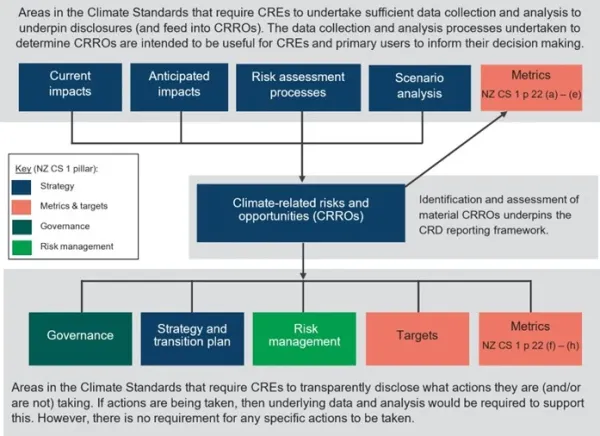Addressing common misconceptions
The CRD regime requires mandatory disclosure, not mandatory action
The CRD regime is a disclosure regime and does not mandate any business or strategic actions that must be taken. Instead, some disclosures require CREs to undertake sufficient data collection and analysis, and others require disclosure of what a CRE is or is not doing. Diagram 1 below illustrates this for each pillar of the Climate Standards, including some processes that feed into those pillars.

Diagram 1: Underlying processes required in the Climate Standards that support transparent disclosure
There are some nuances within the risk management, metrics and targets pillars:
Risk management
- Given CREs are required to disclose material climate-related risks, we would expect to see a description of sufficient processes to identify and assess risks in the risk management pillar7. There is no requirement to take action to manage climate-related risks and opportunities, but there is a requirement to disclose this action or inaction.
Metrics
- Some metrics require data collection and analysis due to NZ CS 1 p 22 (a) – (e) and other metrics require disclosure of what a CRE does or doesn’t do based on paragraphs 22 (f) – (h). If CREs do have processes that would answer the requirements of disclosures 22 (f) – (h) (such as capital deployment), then they would be required to have underlying data and analysis to support this.
- While CREs are required to undertake sufficient data collection and analysis to calculate GHG emissions and GHG emissions intensity, there is no requirement to reduce these emissions.
CREs can decide how to respond to their data, analysis and resulting risk, opportunity, impact and scenario analysis disclosures. The regime does not mandate actions, such as improving climate resilience, reducing GHG emissions, pursuing climate-related opportunities, or governing or managing climate-related risks in a certain manner (if at all).
The information disclosed in climate statements should enable users to make their own assessment of how CREs are considering climate-related risks and opportunities, so they can then make informed decisions based on these assessments.
Our monitoring activities help ensure the information in climate statements complies with the requirements of the Climate Standards and is transparent. Our regulatory oversight does not include requiring CREs to make strategic decisions about how to act on climate change or directing the allocation of capital (or stating a preference for where it should be allocated). These are strategic decisions made by CREs themselves.
Example: transition planning
Misconception 1: Having a transition plan is mandatory
The Climate Standards require CREs to include information when describing how they will position themselves as the economy transitions towards a low-emissions, climate-resilient future state8. The Climate Standards do not mandate that CREs must have a transition plan, or set out any specific approach or process for transition planning. It is possible for a CRE to disclose that there is no change to how they will position themselves and therefore they do not have any mitigation or adaptation targets.
When reviewing transition planning disclosures, we will consider whether there have been reasonable efforts to disclose sufficient information for each requirement of paragraphs 16(a), (b) and (c) of NZ CS 1.
For example, a CRE should disclose:
- whether it has (or does not have) any transition plan aspects of its strategy, including if its business model and strategy might (or might not) change to address its climate-related risks and opportunities9; and
- material information regarding the extent to which transition plan aspects of its strategy (if any) are aligned with its internal capital deployment and funding decision-making processes10.
Misconception 2: A transition plan is required to be a formalised, standalone and/or comprehensive document
The definition of ‘transition plan’ set out in NZ CS 1 is “an aspect of an entity’s overall strategy that describes an entity’s targets, including any interim targets, and actions for its transition towards a low- emissions, climate-resilient future”.
CREs can meet the definition of a transition plan in the Climate Standards without having a formalised transition plan document. Many CREs already have some or all of the key elements of a transition plan because they have committed to and implemented mitigation and/or adaptation targets and actions, therefore meeting the defined requirements.
The nature of transition planning disclosures means they will vary between CREs, as they depend on individual strategic responses.
Value of the transition planning process
Although the Climate Standards only require disclosure of what a CRE is or is not doing, the value of the transition planning process is the development of long-term strategic resilience. The process of formulating and disclosing this information helps:
- enable CREs to build resilience to critical uncertainties;
- inform primary users about the actions CREs will take to achieve their mitigation and adaptation targets;
- provide credibility to the claims and commitments CREs have made; and
- mitigate the risk of legal issues such as greenwashing.
7 Refer to NZ CS 1 paragraphs 18 (a) and 19 (a).
8 NZ CS 1 paragraph 11(e), and paragraph 16 (a), (b) and (c).
9 Refer NZ CS 1 paragraph 16 (b)
10 Refer NZ CS 1 paragraph 16 (c)


